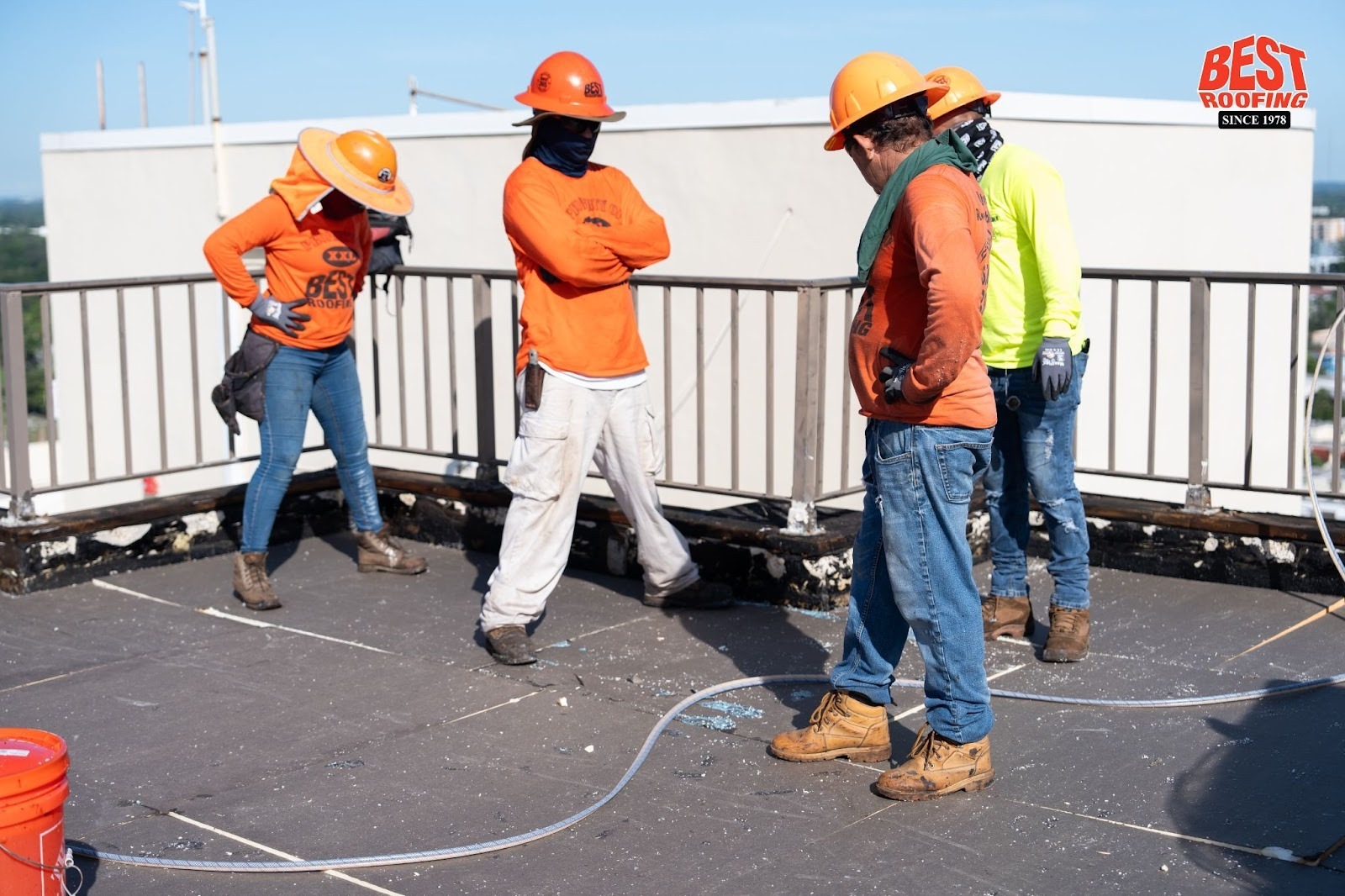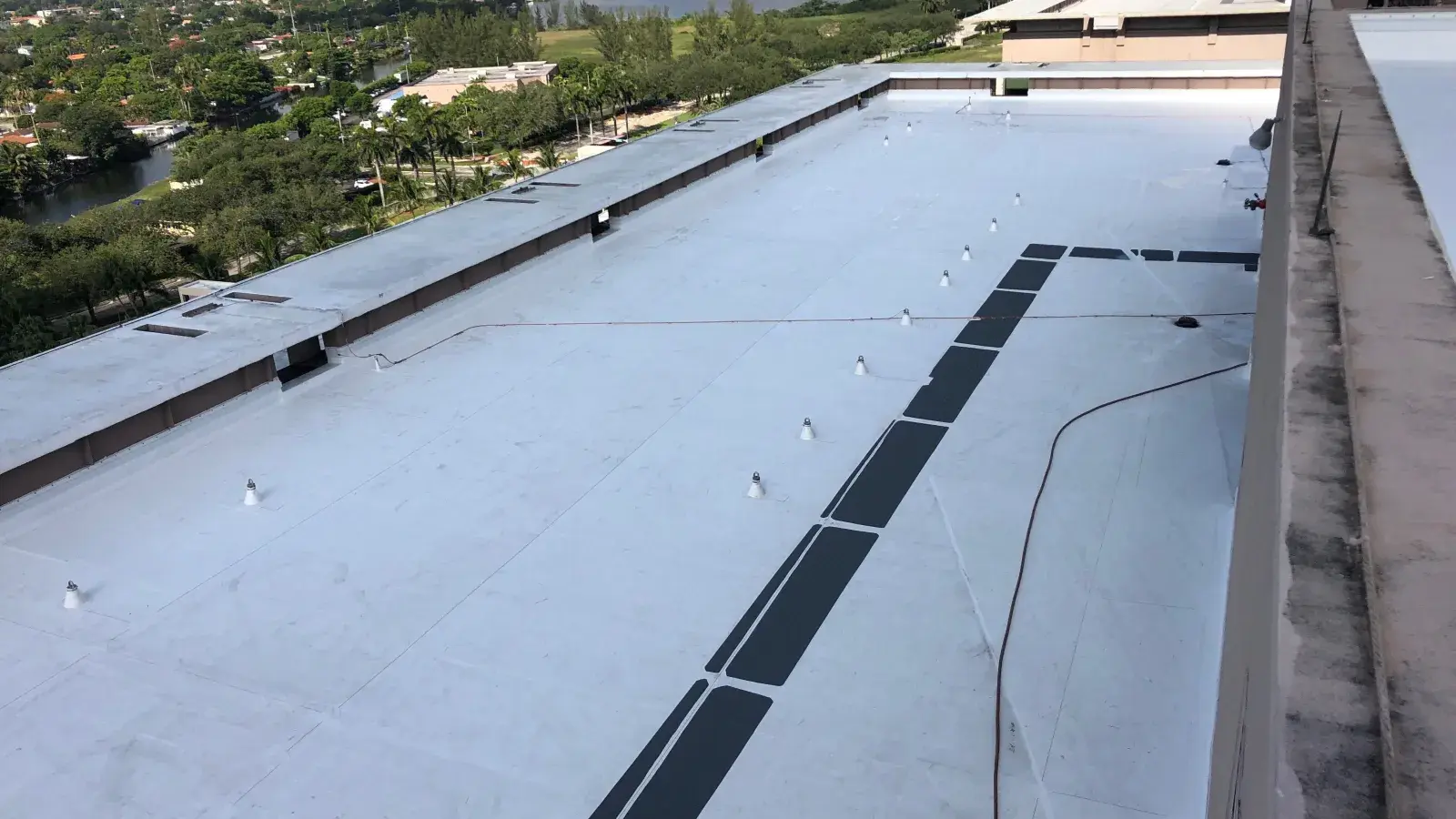The main types of commercial low-slope roofs used in Florida are BUR (Built-Up Roofing), Modified Bitumen, TPO, PVC, and standing-seam metal systems (used on low-slope roofs, not flat roofs).
Each system has its strengths and the appropriate choice depends on your building’s location, use, and long-term maintenance strategy.
This guide will help you compare the most common options and make an informed, confident decision for your next project.
Quick Comparison: What’s Best for Your Building?
|
Roof Type |
General Characteristics |
Reflectivity (Varies by Product/Color) |
Wind & Weather Performance |
Maintenance Level |
|
TPO |
Lightweight, heat-welded seams |
High for white CRRC-rated products |
System Dependent Low |
Low |
|
PVC |
Chemical-resistant, heat-welded |
High for white CRRC-rated products |
System Dependent Low |
Low |
|
Modified Bitumen |
Multi-ply asphalt-based membrane |
Varies by surfacing |
System Dependent Moderate |
Moderate |
|
BUR (Built-Up) |
Multi-ply asphalt/felt system |
Varies by surfacing |
System Dependent Moderate |
Moderate |
|
Metal |
Long-service life materials |
High for light/reflective finishes |
Engineered Wind Resistance Required |
Low |
Built-Up Roofing (BUR)
Best for: Maximum durability and long-term performance.
Built-Up Roofing often called “tar and gravel” — has been used for more than a century. It consists of multiple layers of bitumen and reinforcing felts, topped with gravel or a reflective coating for UV protection.
Advantages:
- Multi-layer design provides redundancy and long life.
- Excellent fire resistance and impact durability.
- Can accommodate foot traffic when walk pads or designated protection paths are installed.
Considerations:
- Heavier system that requires a strong structural deck and skilled installation.Structural capacity must be confirmed by a licensed engineer.
- Often chosen for older commercial or institutional buildings that prioritize reliability over speed of installation.
Modified Bitumen (SBS / APP)
Best for: A durable multi-ply option suitable for heat exposure when properly specified.
Modified Bitumen systems use asphalt enhanced with polymers for strength and flexibility.
They’re typically installed as rolled membranes, either torch-applied, hot-mopped, or self-adhered.
Advantages:
- Excellent UV and heat resistance.
- Flexibility helps accommodate thermal movement.
- Easy to maintain and repair.
Considerations:
Proper installation is critical; seam adhesion and torch technique determine long-term watertight performance.
Two-ply SBS systems generally offer increased redundancy compared to single-ply sheets, consistent with NRCA guidance.
Single-Ply Roofing Systems (TPO, PVC)
Best for: Energy efficiency and fast installation.
Single-ply membranes are lightweight, factory-manufactured sheets of synthetic material that create a clean, continuous barrier. They’re the most common commercial flat roofing systems in the U.S. today.
TPO (Thermoplastic Polyolefin)
- White, CRRC-rated TPO products can help reduce roof surface temperatures.
- Strong heat-welded seams for watertight protection.
- Provides resistance to mold, UV exposure, and punctures; performance varies by membrane thickness and substrate.
PVC (Polyvinyl Chloride)
- Ideal for facilities with chemical or grease exposure (restaurants, factories). Chemical compatibility must be verified with manufacturer's guidelines.
- High flexibility and long lifespan.
- Reflective for energy efficiency and code compliance.
Standing-Seam Metal Roofing
Best for: Long-service-life option for low-slope roofs with engineered wind design.
Standing-seam metal roofs feature interlocking panels that direct water away from the roof surface. Wind uplift performance depends on engineering to ASCE-7 design pressures and the use of approved fastening systems.
Advantages:
- Long service life when properly maintained.
- Reflective finishes improve energy efficiency.
- Recyclable and sustainable materials.
Considerations:
- Higher upfront investment but very low long-term cost.
- Metal retrofits may be appropriate when slope and structural capacity permit.
How to Choose the Right System

Selecting the best commercial flat roof starts with a few key questions:
- What’s the building used for?
Warehouses, offices, and food facilities have different performance needs. - How much traffic does your roof get?
Frequent maintenance access means choosing a tougher surface like Mod Bit or BUR. - What’s your energy goal?
Light-colored TPO, PVC, and metal systems can reduce cooling costs significantly. - How critical is installation speed or disruption? Some systems allow phased or quicker installation depending on site conditions.
Total lifecycle cost depends on design, installation, environment, and maintenance.
The Role of Preventive Maintenance

Even the best roof system depends on care and consistency. Preventive maintenance can double the life of your roof and reduce emergency repair costs.
A professional maintenance plan should include:
- Biannual inspections (before and after storm season) (Matches Firestone guidance)
- Drain and scupper cleaning to prevent ponding
- Seam and flashing touch-ups before they cause leaks
- Photo documentation for capital planning and insurance compliance
These steps protect your investment, keep warranties active, and prevent small issues from turning into expensive repairs.
Plan Your Next Roofing Project with Confidence
Understanding the types of commercial flat roofs is just the first step. The real value comes from choosing a partner who can look beyond materials and think strategically about your entire roofing asset — from design to long-term performance.
A qualified roofing expert doesn’t just install a system; they assess your property’s unique conditions, including:
- Age and condition of your current roof
- Building use and access requirements (e.g., tenant operations, rooftop equipment, or restricted hours)
- Wind zone classification and local code compliance
- Energy efficiency goals and reflectivity requirements
- Budget and capital planning timeline
At Best Roofing, we’ve spent more than 46 years helping Florida property managers, building owners, and community associations make smart, data-driven roofing decisions. From new installations and reroofs to preventive maintenance programs and capital budget forecasting, our goal is simple: to keep your buildings dry, compliant, and operational year-round.
Ready to get a clear, professional assessment of your roof’s condition and needs?
Schedule a comprehensive roof inspection or request a proposal today to see exactly what your property needs: no surprises, no sales pressure, just clear recommendations from a trusted commercial roofing partner.



